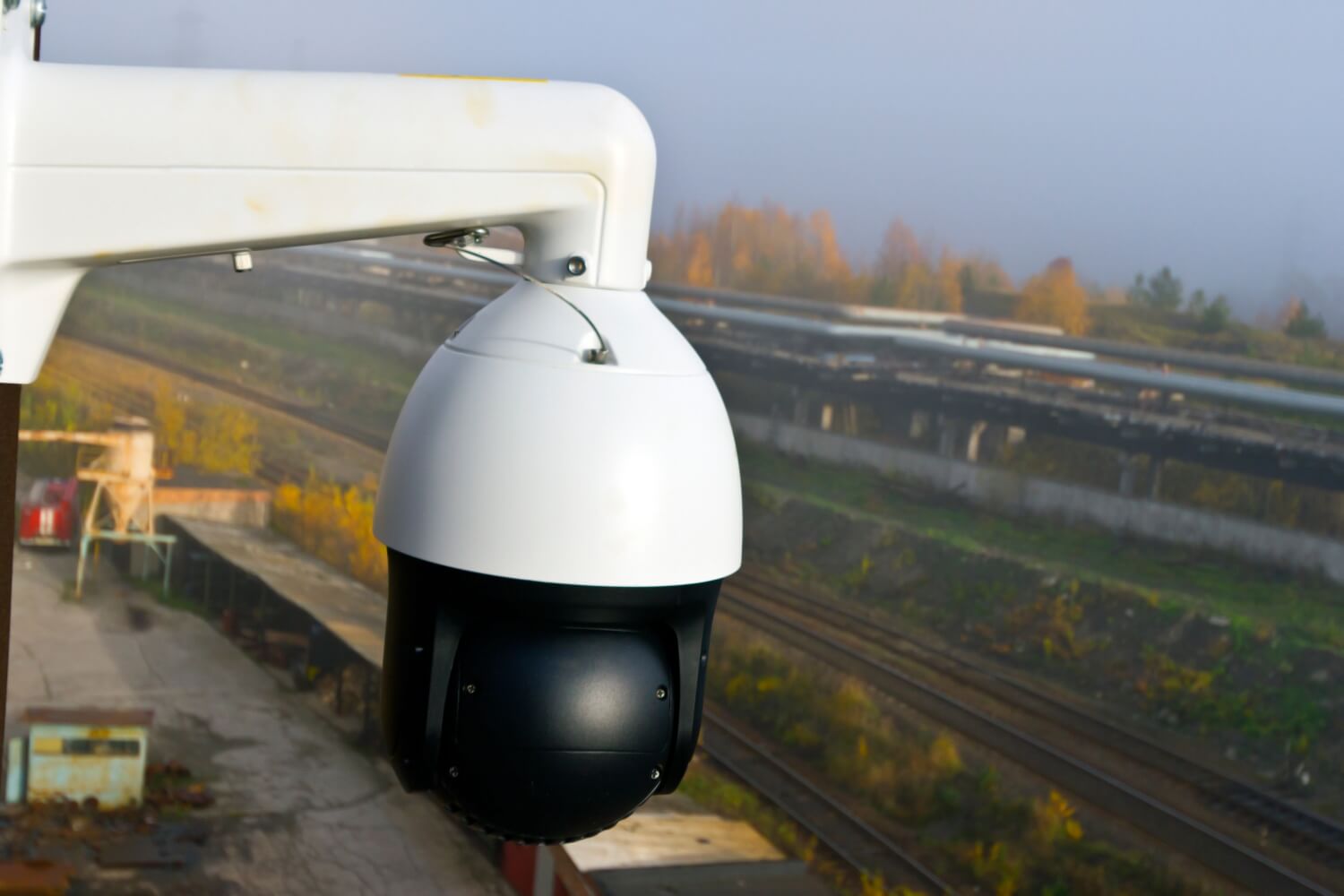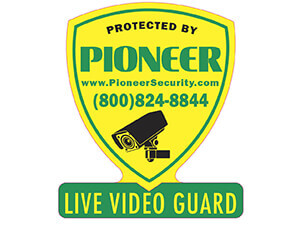Traditional fixed security cameras capture only a single angle, often missing critical activity outside their field of view. They offer a limited field of view, and to overcome this drawback, you’d have to spend more on installing multiple fixed units to cover a larger area.
PTZ cameras let you pan left or right, tilt up or down, and zoom in close. That means you can sweep a parking lot, track a person as they walk, or zoom in on a license plate from afar.
This blog takes a closer look at how PTZ cameras work, why they enhance site security, where they work best, and how they compare to fixed cameras.
Continue reading to understand why PTZ is a wise choice for any surveillance setup.
What is a PTZ Camera, and How Does it Work?
A PTZ (Pan-Tilt-Zoom) camera is a type of motorized surveillance camera that gives users remote control over three key movements:
-
Pan: The camera rotates horizontally, typically between 180° to 360°, allowing it to scan large areas from side to side.
-
Tilt: The lens moves up and down to monitor multi-level spaces or vertical structures like stairways or building exteriors.
-
Zoom: PTZ cameras use optical zoom, which adjusts the physical lens elements to magnify the image without losing resolution. This is essential for capturing license plates, facial details, or distant movement.
These movements are powered by internal motors and gears that work smoothly and precisely. You can control them manually via a joystick, mobile app, or computer, or automate them using preset patrol paths, motion-triggered alerts, or video analytics.
What Sets PTZ Cameras Apart from Standard Surveillance Cameras?
PTZ cameras stand out because of their versatility and responsiveness. Here are some unique features:
-
Preset Tours: You can program the camera to patrol specific points on a schedule, rotating and zooming automatically to cover critical areas.
-
Auto-Tracking: Some PTZ models can detect movement and follow a subject across the field of view, keeping them in frame without manual control.
-
High Optical Zoom Levels: Many PTZ units offer 20x, 30x, or even higher optical zoom, allowing you to maintain image clarity at long distances.
-
Night Vision & Weatherproofing: PTZ cameras often include infrared night vision cameras and are built for outdoor use with weather-resistant housing.
-
Remote Control & Integration: PTZ cameras integrate with broader security systems and can be managed remotely via network video recorders (NVRs), cloud platforms, or mobile apps.
With a single PTZ camera, you can often replace the need for multiple fixed units. Its dynamic coverage makes it ideal for large parking lots, perimeters, warehouses, and any location where constant repositioning would otherwise require human intervention.
Certainly. Below is a revised and more in-depth version of the section. It avoids fluff, AI-style phrasing, and surface-level commentary while adding technical and practical context to each benefit.
Key Advantages PTZ Cameras Provide for Better Security

PTZ cameras bring a range of capabilities that fixed systems simply can’t match.
From wider coverage to intelligent tracking, here are the key advantages that make PTZ technology a powerful addition to any security setup:
Broader Surveillance Coverage with Fewer Devices
Large properties often require extensive coverage, but installing multiple fixed cameras can be costly and complex. A single PTZ camera, strategically mounted, can pan across vast areas, tilt to different elevations, and zoom to capture distant details.
This versatility allows one device to monitor zones that would typically require several fixed cameras. The result is a streamlined installation with fewer units, reduced wiring needs, and simpler network configuration, cutting both capital costs and long-term maintenance overhead.
Intelligent Tracking of Movement in Real Time
PTZ cameras equipped with auto-tracking capabilities can detect and follow moving subjects automatically. When motion is detected, such as a person walking through a restricted area or a vehicle approaching after hours, the camera shifts to follow the movement without operator input.
Some models include built-in analytics to differentiate between routine and suspicious behavior, such as lingering near access points or fast, erratic motion. This automated response allows the camera to stay focused on potential threats, supporting security teams with real-time visibility where it matters most.
High-Fidelity Detail with Optical Zoom
Unlike digital zoom, which enlarges pixels and compromises image quality, optical zoom uses internal glass lenses to magnify a scene while preserving clarity. This is essential for long-range identification, such as reading license plates from a gate entrance or recognizing a face across a parking lot.
The image remains sharp and usable even at full magnification. This clarity becomes critical in forensic investigations, as law enforcement and insurance providers often require footage that clearly shows details for identification or claims.
Scheduled Patrols for Continuous Oversight
Security operations often face time constraints, and manual camera control is not always feasible. PTZ cameras can be programmed to follow a series of predefined positions at set intervals, scanning vulnerable or high-value zones throughout the day and night.
Each stop on the patrol route can be timed to allow sufficient observation before the camera moves to the next point. This repeatable schedule creates a layer of consistency in surveillance coverage and discourages opportunistic intrusions, as the camera’s movement signals active monitoring.
Strong Performance in Low Light and Night Conditions
Security incidents often occur in low-light environments, where standard cameras are less effective. Advanced PTZ models incorporate infrared (IR) LEDs or ultra-low-light sensors that maintain visibility after sunset. These cameras can automatically switch between daytime color video and nighttime black-and-white infrared modes depending on lighting conditions.
This transition happens in real time, without interruption to the video feed. As a result, sites remain under continuous surveillance, and suspicious activity can be captured even in total darkness.
Fewer Blind Spots with On-Demand Movement
Fixed cameras offer a static view, which creates blind zones that can be exploited. PTZ cameras reduce this limitation by responding to live conditions. When another camera or sensor detects suspicious activity, the PTZ unit can be commanded to move to that location and zoom in for closer inspection.
This ability to reposition on demand minimizes coverage gaps and provides flexibility in responding to events as they unfold. In a multi-camera system, PTZs work best when paired with fixed units that maintain continuous recording while the PTZ handles active scanning and threat response.
Integrated Response to External Triggers
Modern PTZ systems can connect with external sensors such as door contacts, motion detectors, glass-break sensors, or intrusion alarms. When one of these devices is triggered, the PTZ camera can be programmed to pivot to the exact location of the alert automatically.
This type of integration provides immediate visual confirmation of the event and supports faster decision-making by security staff. It transforms the surveillance network into an interactive detection and verification tool that bridges the gap between alarm and visual evidence.
Enhanced Emergency Monitoring Capabilities
In urgent situations, such as a fire, break-in, or medical emergency, security personnel need a flexible visual tool that can shift perspective quickly. PTZ cameras allow operators to scan entire building exteriors, zoom in on exits or entry points, and observe upper floors or rooftops with a single device.
They also help emergency responders gain situational awareness in real time, supporting safe evacuations or coordinated responses. The ability to zoom out for context and then immediately focus on critical details offers a significant advantage during fast-moving incidents.
What Are The Best Applications for PTZ Security Cameras?
PTZ cameras work best when you need both broad coverage and close-up detail:
-
Commercial parking lots and loading docks: Sweep the whole area and zoom in on vehicles or individuals.
-
Educational campuses and school grounds: Track students, staff, and visitors across large fields and walkways.
-
Event venues and stadiums: Monitor crowds, watch entry gates, and zero in on any disturbance.
-
Construction sites and critical facilities: Protect valuable equipment and buildings, even in low light.
-
Gated residential communities or large estates: Patrol driveways, fences, and access points without multiple cameras.
In each of these settings, PTZ’s agility and zoom capabilities make it a more intelligent choice than fixed cameras alone.
Some Limitations of PTZ Cameras to Be Aware Of

PTZ cameras offer many advantages but have a few drawbacks:
-
Single focus at a time: PTZ cameras can pan, tilt, and zoom, but they can only record one area at a time. If the camera is focused on one subject or direction, it may miss activity occurring elsewhere in the scene.
-
Fixed cameras for continuous coverage: Because of this limitation, PTZ cameras are often used in combination with fixed cameras. The fixed units provide constant wide-angle coverage, while the PTZ camera can be directed to zoom in or follow movement as needed.
-
Higher cost: Quality PTZ units and intelligent analytics add to the price, and you may need a professional setup.
-
Complex configuration: You must plan presets, patrol routes, and alarm verification carefully. Otherwise, coverage gaps can remain.
A balanced approach uses PTZ cameras for active roaming and fixed models for uninterrupted background coverage.
PTZ vs. Fixed Cameras – A Functional Comparison
Let’s take a closer look at how a PTZ camera compares to a fixed camera:
|
Feature |
PTZ Camera |
Fixed Camera |
|
Field of View |
Moves to cover broad areas |
Static view |
|
Tracking of Moving Subjects |
Manual and automatic |
None |
|
Zoom Quality |
High-resolution optical zoom |
Digital zoom with reduced clarity |
|
Blind Spot Management |
Dynamic adjustment |
Potential coverage gaps |
|
Response to Alarms |
Immediate pan-tilt-zoom to the event |
Records only |
|
Cost |
Higher |
Lower |
This comparison shows why PTZ cameras handle active monitoring best, while fixed cameras excel at constant background recording.
Frequently Asked Questions
Are PTZ cameras good for home security?
They can be, especially on larger properties. A PTZ unit lets you scan a long driveway or yard and zoom in on visitors. For smaller homes, use a PTZ at the gate plus fixed cameras at doors and blind spots.
What are the benefits of PTZ cameras?
You get active tracking of moving targets, clear optical zoom, routine preset patrols, strong low-light performance, and automatic response to alarms. Together, these features help prevent incidents and provide clear footage for later reference.
What does pan and tilt mean on a security camera?
Pan is horizontal movement—rotating left or right. Tilt is vertical movement—angling up or down. Both let the camera cover a wide area without moving its base.
What is PTZ in security cameras?
PTZ stands for Pan, Tilt, and Zoom. It means the camera can rotate on two axes and magnify the image, giving you flexible control over what you see.
Switch to Smarter Surveillance and Coverage with PTZ Technology
PTZ cameras elevate your surveillance system from passive observation to proactive security. They allow you to follow movement in real time, zoom in for detailed views, and monitor specific zones through preset patrols. With both broad coverage and focused control, PTZ technology helps reduce blind spots, improve response times, and strengthen overall protection.
If you’re looking to upgrade from basic cameras to a more responsive and intelligent system, Pioneer Security has the tools and expertise to make it happen.
Pioneer Security can design and install a custom PTZ camera system tailored to your property. Reach out today to learn how our expert team brings active monitoring, clear evidence capture, and reliable 24/7 protection to your home or business.



